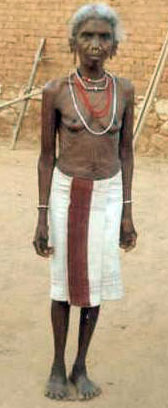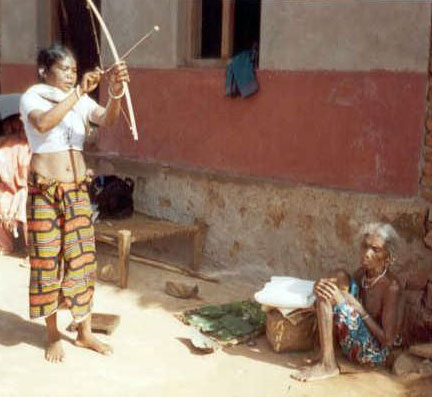Origin, Culture And Kinship Structure Of Hill Saora
Dr. Meera Swain
| Abstract | Physical features, dress, ornaments, art and crafts patterns of “ Saora” tribe |
| Introduction | Saora Kinship |
| Study Area | Conclusion |
Origin, culture and kinship structure of Hill Saora are studied through intensive field surveys carried out in two gram Panchayats: Sagada and Puttasing, of Rayagada district, Odisha. Hill Saora, popularly known as Lanjia Saora, inhabit the forest clad lofty hills in the eastern ghat regions of south Odisha. Hill Saora have their racial affinity to the Proto-Australoid group but have their linguistic affinity to Austro-Asiatic Mundari group. The study depicts the physical features, dress and ornament pattern, art and crafts of Saora tribe. The study reveals the strong belief on ancestral worship of the tribe and the role of Shaman/Shammani who acts as middle man/woman between the deity and the sick, and also as ambassador of God and Goddesses in all kinds of rituals. One of the most distinguishing features of the Saora tribe is that it is clan less and has no totems. The tribe has only lineages called Birinda, which is a local connotation for intimate group and best serves as the title group of saora tribe. The patrilineage, which is the essence of socio-cultural principle of “Saora” tribe, is termed as “Kheja, alternatively known as “Punja” or “Sisha”. After Birinda, the second important kin category is “Kulam”, the specific term of “Saora” used for the affinal relatives. Anseer or Antera , the third important structure of Saora society, is a labour co-oprative of indigenous nature and is formed as per the requirements of Saora tribe. The study also reveals that the Saora tribe, though with time, is subjected to the changing economic, political and religious conditions, yet it maintains its traditional culture.
1. Introduction
Kinship is the main structuring factor of all human societies and has remained the most curious field of research by most of the anthropologists. The management of each and every aspect of society is possible by observing the principles underlying the ‘kinship’. In order to get a clear picture of a particular culture and society, the arrangement within the ‘kinship’ system and the management of the same is to be studied scientifically and systematically. Here the arrangement is referred to different status position of the relatives, the network involved in it, and also the divergence of sentiments and interests that lead to conflicts. So, for the proper understanding of the societal principles one has to go through the vivid picture of the ‘kinship’ structure of a particular society. Various researchers have put forth the definition and concept of kinship from various social perspectives (Mallinowski (1913); Levi-Strauss (1949); Radcliffe-Brown (1950); Beattie (1964); Schneider (1965); Geertz and Geertz (1975); Parkin (1997) ). All kinds of social relations are patterned as per the principles underlying kinship and affinity of that particular society. Beattie (1964) observed that the study of kinship is very commonly used for two important and related purposes. Firstly it provides a way of transmitting status and property from one generation to the next, and secondly in some societies it serves to establish and maintain effective social groups. Therefore, the prime objective of this study is to understand the kinship structure of Saora tribe, one of the most primitive tribes of Orissa and to make a comparative analysis with other major tribes of Orissa. The other objectives of the study are to trace the origin of Saora tribe, to understand their physical features and to focus on their cultural prescriptions such as dress and ornaments, art and crafts etc.
2. Study Area
Lanjia Saoras mostly inhabit in Rayagada and Gajapati Districts of Orissa, India. Rayagada and Gajapati districts were created after 1991 Census. Prior to 1991, these two districts were in the jurisdiction of Koraput and Ganjam district respectively. In Rayagada district, the Saora population is concentrated in six Grama Panchayats(GP) of Gunupur Subdivision, viz., Puttasing, Sagada, Tolona, Jaltar, Chinasari and Kulusing. Field studies were conducted in two villages of Sagada (Kereba & Dungdunger) Gram Panchayat and two villages of Puttasing Gram Panchayat (Rejingtal & Jongjong). Preliminary observations were made at Serango GP of Gumma Block in Paralakhemundi subdivision of Gajapati district. These study areas come under Eastern ghat hill ranges.
In the present study, the study of the origin, culture and kinship structure of the Saora tribe is undertaken by adopting six methods namely Rapport Establishment, Observation, Interview, Interview Guide, Census schedule, and Case Study Method.
The Hill Saora or Lanjia Saora is one of the most primitive tribes of Orissa. A few earlier studies on” Saora” have accorded a distinctive status to its culture and social strength as compared to other tribal societies. They inhabit mostly in the lofty hills, deporting mountains, flowing streams and gapping valleys. The term “Saora” appears to have two connotations. One derived from ‘Sagories’ the scathian word for axe and other from ‘Saba Roye’ the Sanskrit term for carrying a dead body (Pattanayak, 1989). Both of them fit well with their habit of carrying dead and axe always on their shoulders with their primitive occupation of hunting. “ Saoras” are called by various names such as Savara, Sabara, Saur, Sora etc. and show their racial affinity to the Proto-Australoid group. Structure of Munda speakers (Fig. 1) also reveal that “Saora” belong to Austro-Asiatic Mundari group and mostly inhabit north of undivided Koraput district of Odisha. The “Saoras” are supposed to have inhabited in this tract of land, prior to the coming of “Gonds”, another aboriginal tribe of Southern Orissa. This is inferred from the strong influence of the Munda language over that of Saoras (Tirkey, 1989). The earliest reference to the “Saora” is found mentioned in the book “Castes and Tribes of the Southern India” by Thurston (1909). He says “Saora”, or “Sawara” are one important hill tribe of Ganjam and Vizagpatnam; they have derived their name from the Scegethian Sagar, an Axe in reference to the axe, which they carry in their hand. On the origin of tribe, he has referred to the Rigveda, where in cites that Saoras have been claimed to have been descended from Viswamitra, while in the epic Ramayana they are shown to have emanated from the body of Vaisistha’s cows to fight Viswamitra. Referring to the Grierson, he says their language is included under Mundari family.
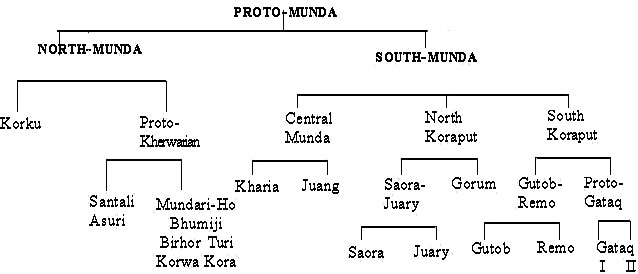
Figure 1: Structure of Munda speaker
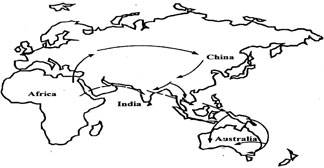
Figure 2: Schematic representation of the two alternative hypotheses suggesting possible routes of earliest migration of people into Indian subcontinent (adopted from Kumar and Reddy (2003))
According to Fawcett (1888) Saoras are most industrious. They show remarkable engineering skill in constructing paddy fields but are physically inferior to “Kondhs”. They give half of their products to parasitic “Bisoies”. Mohanty (1989) made an ethnographic presentation of the “Saora” and suggested that the term has two connotations. One of them is derived from the scythes land “Saora” means axe and the other from the sustain term “Sabaraja” which means carrying a dead body. He also mentioned that physically they are not as strong as other tribes of Orissa.
Kumar and Reddy (2003) suggested that the communities, which are affiliated to the Austro-Asiatic linguistic family, are perhaps the first to settle in India, whereas the palaeo anthropological evidences date the earliest settlements around 60,000 years BP. One of the hypotheses tracing the migratory routes indicate that the tribes speaking Austro-Asiatic languages have come from Africa, and have entered India through the western corridor ( Nei and Ota 1991; Chu et al. 1998; Majumdar 2001). The alternative hypothesis, which is in vogue, is that these groups have migrated from China to India through the north eastern corridor ( Ballinger et al. 1992; Gadgil et al. 1998; Diamond, 1997). Figure 2 gives a schematic representation of the migratory routes concerning the two hypotheses. Neither of these hypotheses could so far muster adequate and unequivocal empirical support to validate any of the competing hypotheses with reasonable evidence. It is observed that the Saora are genetically closer to Paranga than to other Mundari speaking tribes of southern Orissa. Saora of south Odisha were forced to leave their original place by the pressure of the Aryan groups and selected hills and forest regions as their habitats. It was suggested that “Lanjia Saora” tribe had migrated to the forest and hills of undivided Koraput and Ganjam districts of Odisha from the plains of Mandasa in the Srikakulam district of Andhra Pradesh, on being driven away by their kinsmen.
4. Physical features, dress, ornaments, art and crafts patterns of “ Saora” tribe
|
Kumar and Reddy (2003), on the basis of four anthropometric variables viz. stature, cephalic index, nasal index and facial index, showed that “Lanjia Saora” also resemble other twenty two tribes. The “Saora” are below the middle height; face rather flat; cheekbones high; eyes slightly oblique. They are as fair as the Uriyas, and fairer than Telugus of the plains. Compared to the height of the other tribes, they are shorter and the face is distinctly Mongolian”(Thurston,1909). But Mazumdar (1963), in his anthropometric survey of 100 “Saoras” in Ganjam in South Orissa could not trace any Mongoloid tinge in the racial composition of the community. Their stature generally ranges from ‘short’ to ‘below medium’ category. They are having bulging bellies, large forehead, drooping ears, big mouths, short arms and legs (Figure 3). |
|
|
Dress pattern: The traditional dress of male “Saora” is the loincloth, approximately of 6 (six) inch long and 10(ten) inch wide. It is tied around the waist passing between the thighs to cover the private part leaving one and half feet hanging in the back. Similarly, the females of “Lanjia Saora” community use to cover the lower part of their body by handmade napkin leaving the upper part traditionally quite naked (Fig. 7). Because of their traditional dress (Figure 3 and 4), which appear like “Lanja or Tail”, they are called “Lanjia Saora”. In recent times, females use a dress for their upper part, which is called “Arbicap”, and the dress covering the lower part of the body is called “Goracap”. Now a days, most female Saoras wear blouse to cover the upper part of their body while the lower part is covered by a towel or napkin wrapped around the waist. Presently, it is observed that the younger generation male and female “Saoras” wear dress same as the male and female of the modern society; viz; Saree, blouse, Chudidar, Punjabi,langa, Pant and Shirt( Figure 4) |
|
The traditional dress of “Lanjia Saora” are woven by the “Doms” and “Panos” but are spun by the “Saoras”. The “Saoras” do not weave the cloth as it is forbidden to do so by tribal law. Besides, the “Saora” dress also consists of large bunch of feathers stuck in his hair on the crown of his head, a coloured cloth as turban and worn on the back of the head and folded tightly, which act as a good protection against head. The Gamango and Bhuya have the privilege to wear large coloured turbans, which are red, orange or blue, because they occupy high positions in the “Saora” society and relatively rich. Elwin (1955) in his classical book “The Religion of an Indian tribe” referred to Russel (1856) who mentioned about the traditional dress of “Saora”, which look like a tail. At the time of feast or dance festival, “Saoras” generally wear a short cloth over the shoulder. The female “Saoras” generally tie their hair at the back of the head and some time confined with a fillet (Thurston, 1909).
Ornaments: The “Saoras”, both male and female, are very fond of ornaments. They decorate themselves with natural ornaments like feathers, flowers, leaves and grass or even by the seeds( Figure 5). For a female “Saora” different parts of the body are given importance for wearing the ornaments. Ear gets the first preference. From the childhood, the girl endures a painful operation and discomfort in the ear, which last for about a decade. Holes are made in the lobes, which are gradually enlarged, first by the insertion of bits of straw and reed and then by wooden plugs of tamarind or the spadix of Sago palm (Thurston, 1909). Subsequently, the wooden plugs are replaced by ordinary brass spiral springs purchased from the local weekly market. Twelve to fifteen earrings are worn by the “Saora” woman in the form of a loop, which are pierced in the ear. Making of holes in lobes is a customary practice among the “Saora” and it takes place when a “Saora” girl attains her puberty.
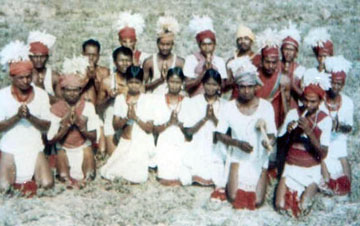
Figure 5: Saora male and female members dressed with traditional dress, feathers and playing flute before performing a saora dance.
Following the ear, hair and throat are given importance for wearing the ornaments. “Saora” women comb their hair carefully, collect them into a bun and tuck them underneath so that it appear like ball to the left of the head. Then it is fixed by a band of fiber or black cloth inlaid with tiny bits of glass. “Saora” women also wear brass chains, brass flowers. But the most characteristic ornament is the brass pin with its large pike. It is very common to see women with the pin projecting to the left and leaf pipe projecting to the right like a pair of little horns (Thurston, 1909). Use of cowries widely sewn in clusters on their cloths in the shape of stars and flowers as skirt borders (Singh ,1967). “Saora” women decorate their throat with varieties of necklace made of brass, silver or alloy and are fond of covering their breast profusely with bead strings and the different ornaments. In the nose, “Saora” women wear three little rings, those in the alar are flat and round, and the one in the septum is thicker and shaped like a heart. They also wear brass bracelets on their waist and cover their fingers with rings as many as twenty on each hand. On the leg, women wear bronze or aluminum anklets and rings on the toes. Like females, male “Saora” are also fond of ornaments. They put cheap rings in the ear, nose and around the wrist. Sometimes, they hang a floppy necklace of beads round the neck. However, with the passage of time these ornaments have lost their popularity and “Saoras”, who can afford, are now wearing golden and modern designed ornaments.
The ornaments which are in common use are: rajangtang, pagawada, khajatang, Jartang, dadaillu, pirpiria, tanagrallu, kudumi, sunnatang, khaddu , susidang etc.
Another distinctive feature of “Saora” culture is tattooing. Most of the “Saora” women have this tattoo, which is the line down the middle of the forehead, dots on either side of the line, on their cheeks and on the point of the chin. The reasons for the tattoo marks as mentioned by Elwin (1955) are for beautification. Russel and Hiralal (1916) further emphasized the role of tattoo as sexual passion for women.
Art and Crafts: Tribal art and crafts are symbols of beauty, which enchant the common man since time immemorial. Fancy, fear, sensation and imagination form the centre of tribal art. As art imitates life, careful study of the art and crafts of “Saora” will shed considerable light on the cultural and traditional evolution of the tribe. The artistic skills of “Saoras” are very much revealed in their paintings. These paintings are called ‘Idital’ or ‘ikons’ and are meant for various religious occasions. These ikons are sketches of human beings, horse, elephant, gunman, aeroplane, cycle, Sun, moon etc. arranged in an artistic manner. Paintings are prepared representing occasions like Nuakhia (Abdur) (Figure 6), birth occasion, karjya, kudanboi teaching, guar etc.. The routine procedure is for the Shaman or Shamani to recommend the painting of an ikon as one of the means of satisfying a God or ancestor who has brought home a trouble. The making of an ikon may be the pivotal point of a ceremony or may be auxiliary with some sort of sacrifice. As the regular festivals come around, the renewal of the old paintings, especially those for improving the fertility of the crop is accepted as a normal religious obligation ( Elwin, 1955).
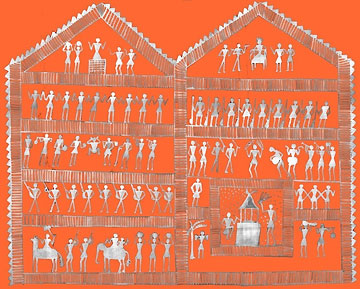
Figure 6: Idital on the occasion of Nuakhia(Abdur)
The artists who are specialized in ‘wall paintings’ usually draw these paintings. Many of the Shamans also combine this art with their regular professional duties. The shamans are termed as ‘kudan’ and the shammanis are termed as ‘kudanboi’( Figure 7 & 8). They are the main link establishers between the Saora people and the other world where ancestors and deities live. Before the painting is drawn, the artist offers rice and wine to the concerned God or ancestor and begs an apology for any mistake that might arise in the process. These paintings are drawn mostly on the wall and are commonly known as wall paintings. Besides, these are also drawn on drawing sheets, canvas. The artist uses rice-flour and water mixed in a small bowl, or sometimes mixture of ashes and water. Mostly the paintings are drawn in white on a red or black background.
|
|
|
|
Figure 7: Kudanboi with traditional dress and ornaments (left) |
Figure 8: Kudanboi using the traditional method against bad souls while treating her patient. |
The common belief is that through an ikon, the “Saora” flatters and pleases the God and ancestors so that they may spare the members of the household from their invidious attention. Houses and monuments are shown symbolically in geometric patterns of great variety. The peculiarity of the painting is that there is no distinction between male and female. Thus, these ikons are nothing but graphic representations of their important socio-religious activities and therefore are difficult to understand. Watts (1970) has discussed by referring the work of Shaman and position in healing process. He has narrated how the Shaman acts as middleman between the deity and the sick and also narrates the reason and processes of sacrifice. The Shaman (Kudan) acts as the ambassador of God and Goddess through whom the news of good and bad passes through.
Kinship is an embellishment of the whole social system in each given society. Its characteristic features elucidate the various services it renders. Finding its growth from the basic social group i.e. family to the extended boundary of the social structure, it ensures the stability in the economic, political, and religious and other social spheres. The data on kinship reveals that through these social structures among Saoras, it regulates the interpersonal relationships among the kin members. Kinship abides different kin members through patterned rights and obligations.
The Saora have only lineage called Birinda, which is exogamous but not totemic, usually confined to a single village, and divided into further sub units for purposes of ritual activity and labour. It is a title group, which is very often used to connote the local descent group. Das (1965-66) has discussed about the ‘Birinda’ organisation of Lanjia Saora. According to him the maximal lineage is the Birinda and the primary function is to regulate marriage. It also maintains brotherhood, which is observed during the life–cycle rituals and in different economic activities. It also helps to decide the inheritance rules. Genealogical memory is generally shallow, three or four generations at most, so totems are essential labels for the regulation of marriage. However, the present study reveals that in case of “Saora” tribe, genealogical memories extend to about seven to eight generations.
The comparative study of kinship structure of different Orissan tribes shows that “Saora” kinship structure has some uncommon attributes, which is also evident from the writings of Karve (1968). “Saora” kinship system exhibits some distinguishing feature. Though Saora kinship is Patrilineal like other Orissan tribes such as Bondo, Bhunya, Juang and Santhal, it has no such system of clan organization like others. This is a rare attribute, which is also characteristic feature of Hottendote, Bushman and some of the Andaman Islander’s kinship organizations. The Saora are genetically closer to Paranga than other Mundari speaking tribes of southern Orissa. Worship of “Idital” or Ikon, is the way to keep record of these genealogically traceable ancestors, who are worshiped by their descendants. However, the hierarchical structure of Birinda like Gamango, Buyya, Mandala and Raita has served both the socio-economioc and political purpose.
Formerly Birinda was used for identification of different title groups but gradually it extended its definition and spheres of functions to the lineage. In recent years their extended family has been identified as “Kheja”, alternatively known as ‘Punja’ or ‘Sisha’. The patrilineal kins are grouped under “kheja” but the married daughters do not lose the affinity to it even after their death. The dead female members are given enough space along with the male members during the second mortuary rites i.e. “karjya”. It is not only a tribute to the ancestors, but also an exhibition of status and gift exchange, expenditure and large congregation of kins. Thus, the patrilineage is identified as “Kheja”and as per the universal rule of lineage, no affinal relations are preferred or allowed within the members of the “Kheja”.
Another principle that distinguishes “Birinda” from “Kheja” is that the same title group, for example “Dalbehera” of different villages are not necessarily related through patrilineage and the local descent group is referred to as “Birinda”. This local descent group also extends its genealogical linkage to other villages, which can be grouped together under “Kheja”. But the segmentation of “Kheja”(lineage) is not found throughout my study which is a common feature of clan society. This suggests that “Saora” tribe does not have clans and is guided by lineage principles. The relationship of members of a patrilineage is traceable up to a maximum of six to eight generations. The kudan or Kundanboi (Shaman or Shamani) along with the elder members of the “Kheja” are the main proprietors of its functioning on different occasions by calculating the lines of generations and judging the affinal relations. Having affinal relations within “Kheja” is considered incest (Dussar) and marriage alliance has to follow the principles of community. Some examples of matrilineal cross-cousin marriages are also observed.
The second important kin category is “Kulam”, the specific term of “Saora” used for the affinal relatives. The economic power, socio political status and the influential role of the title groups are confined only within their village or area or community. Marriage alliance is always preferred in higher or same title groups. Thus, the entire Saora system of categorizing patrilineal kins and affinal kins follows the principles inherent in the Hindu Caste system and Class structure. However, the class structure in “Soara” society is mostly based on their economic condition and political positions prevailing since the kingship. The political position such as village headship is mostly confined to Gamango Birinda but not limited to the specific Birinda. Freedom and the rules inherent in their social system also allow other Birindas to act in the decision-making and leadership issues by raising their positions (class based) by acquiring money, other properties or positions. In the absence of “Gamango” other title groups like “Dalbehera” or “Badaraita” may take the charge of the village headship as instructed by the “Bisoyoi” under the kingship. Today, the “Sarapanch” has replaced the village headship under the present electoral system.
The members of “Kulam” have their respective roles and responsibilities on different socio-religious and cultural functions and rituals. The principles and the disciplines inherent in the system are reflected in the type of gifts and the exchanges of gifts, the presence and participations of members during rituals and on different periods of cultivation following the principles of “Anseer”, the labour cooperative. The specific role of maternal uncle and father’s sister clearly clarifies their key roles in the kinship structure that integrates the whole network of kins, in the affinal category.
Next to “Kheja” and “Kulam”, Anseer or Antera is considered as the third important structure of Saora society. It is a labour co-oprative of indigenous nature and is formed as per the requirements of Saora tribe. The principle of recruitment to this group is the reciprocity and intimacy. On the above basis Anseer consists of the members of patrilineage particularly of the one’s own village and nearby villages, neighbours and members of Kulam, ritual kins and friends. The hardship involved in the terrace cultivation and shifting cultivation is to some extent lessened with the help of these members. Each family is obliged to send at least one representative to the Anseer. However, when required they hire labour in exchange of paddy or cereals whereas members of Anseer or Anterra exchange and reciprocate labour on similar occasions. This labour co-operative is one of the best examples of self-management within the “Saora” community. The pattern of obligation underlying the cooperative, clarifies the extent of interdependency and thus provides socio-economic liberation. It is functioning beyond the kin groups but keeping the interacting members intact irrespective of title (status) group.
6. Conclusion
The Hill Saora have their racial affinity to the Proto-Australoid group while their linguistic affinity is linked to Austro-Asiatic Mundari Group. The Saora tribe has its own distinctions as a culture group and envisaging the social network for the generations together. The traditions they inherited and the peculiarity they possess, in upholding the socio-cultural principles, are reflected in the economic and political organizations of the (“Saora”) tribe. Though Saora kinship is Patrilineal like other Orissan tribes, it has no such system of clan organization like others. The Saora have only lineages called Birinda, which is a local connotation for intimate group (kheja) and best serves as the title group of Saora tribe. The patrilineage, which is the essence of socio-cultural principle of “Saora” tribe, is termed as “Kheja, alternatively known as “Punja” or “Sisha”. The second important kin category is “Kulam”, the specific term of “Saora” used for the affinal relatives. Anseer or Antera , the third important structure of Saora society, is a labour co-operative of indigenous nature. Years of deprivation (economic) compel them to change and to find some alternatives such as adapting Christianity, migration to other states as labourer. However, the “Saora” are still maintaining their traditional structure of the society.
References
- Ballinger, S.W., Schurr, T.G., Torroni, A., Gan, C.C., Hodge, J.A., hassan, K., Chen, K.H. and Wallace, D.C., 1992: Southeast Asian mitrochondrial DNA analysis reveals genetic continuity of ancient mongoloid migrations, Genetics, Vol-130, p. 139-152.
- Beattie, John, 1964: Other cultures, Cohen and West, London.
- Chu, J.Y., huang, W., Kuang, S.Q., Wang, J.M., Xu, J.J. Chu, Z.T., Yang. Z. Q., Lin, K.Q, Li, P., Wu, M., geng, Z.C., Tan, C.C., Du, R.F., and Jin, L., 1998: Genetic relationship of populations in China; Proc. Natl. Acad. Sci., USA, 95, p. 11763-11768.
- Das, N., 1965-66: The Birinda of the Lanjia Saoras, Adivasi, Vol-VII, No-2, P. 57-60, T.R.B., Bhubaneswar.
- Diamond, J., 1997: Location, location, location: the first farmers, Science, Vol-278, p. 1243-1244.
- Elwin, V., 1955: The religion of an Indian tribe, Oxford University Press, P-597.
- Fawcett, F., 1888: On the Saoras, an aboriginal hill people of the eastern ghats of the Madras presidency, J. Anthropological society of Bombay, vol-I.
- Gadgil, M., Joshi, N, Manoharan, S., Patil, S. and Prasad, U.V.S., 1998: Peopling of India; in The human heritage(eds) D. Balsubramanyam and N.A. Rao( Hyderabad University Press) pp. 100-129.
- Geertz, Hildred, and Clifford Geertz, 1975: Kinship in Bali. Chicago: University of Chicago Press.
- Karve, Irawati, 1968: Kinship organization in India. 3rd Ed. Bombay, Asia Publishing House.
- Kumar, V., and Reddy, B.M., 2003: Status of Austo-Asiatic groups in the peopling of India: an exploratory study based on the available prehistoric, linguistic and biological evidences, J. Biosci., Vol-28, No-4, p. 507-522.
- Levi-Strauss, Claude, 1949: The Elementary Structure of Kinship, 2nd Edition, translated by Rodney Needham(London, Eyre and Spottiswoode).
- Malinowski, Bronislaw, 1913: The Family among the Australian Aborigines. London: University of London Press.
- Mazumdar, R.C., 1963: The history and culture of the Indian People, Vol-IX and X, Bombay.
- Mazumdar, P.P., 2001: Ethnic populations of India as seen from an evolutionary perspective, J.Biosci., Vol-26, p. 533-545.
- Mohanty, B.B., 1989: Material, Culture and technology of the Lanjia Saora, Adivasi, Vol-XXIX, No. 2 & 3, pp 24-28.
- Nei, M. and Ota, T., 1991: Evolutionary relationships of human population at molecular level; in evolution of life fossils molecules and culture(eds) S. Osawa and T. Homjo( Heidelberg: springer-verlag) , pp 415-428.
- Parkin, Robert. 1997: Kinship: an introduction to basic concepts, Blackwell Publishers,UK.
- Pattanayak, N.(Ed), 1989: The Saora, THRITI, Bhubaneswar.
- Radcliffe- Brown, A.R., 1950: Ashanti Kinship. In A.R. Radcliffe Brown. African systems of Kinship and Marriage. London: Oxford University Press
- Russel, R.V., and Hira Lal, 1916: The tribes and castes of central province of India, Vol-IV, London, p 500.
- Russel, G.E., 1856: Selections from the records of the Madras Government, No-XXIV, Vol-II, P-13.
- Singh, V., 1967: Glimpses of Indian culture. Allahabad, P-73.
- Schneider, David M., 1965: "American Kin Terms and Terms for Kinsmen: A Critique of Goodenough's Componential Analysis of Yankee Kinship Terminology." In Formal Semantic Analysis. Ed. E. A. Hammel. 288-308. Special issue of American Anthropologist 67 (5), pt. 2.
- Thurston, Edger, 1909: Castes and Tribes of Southern India, Madras.
- Tirkey, T., 1989: The southern aboriginal tribes of Orissa, Ph. D. Thesis, Berhampur University.
- Watts, N.A., 1970: The half clad tribal of eastern India, Calcutta.
Acknowledgement
The results presented in this paper are part of my Ph. D research studies. I express my sincere gratitude to Prof Prasanna K. Nayak, former professor, Department of Anthropology, Utkal University, Bhubaneswar, Odisha for his valuable guidance and suggestions. I am extremely thankful to the villagers of the villages of my studies, and my informants who extended their whole hearted support and co-operation during my field surveys.



